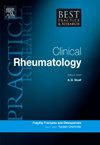The inequity of global healthcare in pediatric rheumatology
IF 4.8
2区 医学
Q1 RHEUMATOLOGY
Best Practice & Research in Clinical Rheumatology
Pub Date : 2024-09-01
DOI:10.1016/j.berh.2024.101983
引用次数: 0
Abstract
In pediatric rheumatology, global health inequity relates to the uneven distribution of healthcare resources, accessibility, and health outcomes among children with rheumatic conditions across various countries, regions, and socioeconomic groups. This inequity can manifest in various ways. This review article provides an overview of common rheumatic diseases, such as juvenile idiopathic arthritis and systemic lupus erythematosus, which significantly contribute to and are affected by disparities in global healthcare.
Subsequently, we delve into the inequalities in accessing patient care, encompassing issues related to diagnosis and treatment. Additionally, we address challenges in educational advancement and identify research gaps within the field of pediatric rheumatology. We also reveal successful global collaborations, such as a Global Task Force for Pediatric Musculoskeletal Health and special working groups among international organizations, aimed at bridging the disparities gap. Through these efforts, we try to enhance understanding, cooperation, and resource allocation to ensure equal access to quality care worldwide for children with rheumatic conditions. Futhermore, we present a case study from Thailand, highlighting their successful initiatives in developing pediatric rheumatology within their healthcare system.
儿科风湿病学全球医疗保健的不平等。
在儿科风湿病学中,全球健康不公平与不同国家、地区和社会经济群体的风湿病患儿在医疗资源、可及性和健康结果方面的分布不均有关。这种不公平现象有多种表现形式。这篇综述文章概述了常见的风湿性疾病,如幼年特发性关节炎和系统性红斑狼疮,这些疾病在很大程度上造成了全球医疗保健的不平等,也受到了不平等的影响。随后,我们深入探讨了患者在获得医疗服务方面的不平等,包括与诊断和治疗相关的问题。此外,我们还探讨了教育进步所面临的挑战,并确定了儿科风湿病学领域的研究差距。我们还揭示了成功的全球合作,如儿科肌肉骨骼健康全球工作组和国际组织间的特别工作组,旨在缩小差距。通过这些努力,我们试图加强理解、合作和资源分配,以确保风湿病患儿在全球范围内平等地获得优质医疗服务。此外,我们还介绍了泰国的一个案例研究,重点介绍了他们在医疗保健系统中发展儿科风湿病学的成功举措。
本文章由计算机程序翻译,如有差异,请以英文原文为准。
求助全文
约1分钟内获得全文
求助全文
来源期刊
CiteScore
9.40
自引率
0.00%
发文量
43
审稿时长
27 days
期刊介绍:
Evidence-based updates of best clinical practice across the spectrum of musculoskeletal conditions.
Best Practice & Research: Clinical Rheumatology keeps the clinician or trainee informed of the latest developments and current recommended practice in the rapidly advancing fields of musculoskeletal conditions and science.
The series provides a continuous update of current clinical practice. It is a topical serial publication that covers the spectrum of musculoskeletal conditions in a 4-year cycle. Each topic-based issue contains around 200 pages of practical, evidence-based review articles, which integrate the results from the latest original research with current clinical practice and thinking to provide a continuous update.
Each issue follows a problem-orientated approach that focuses on the key questions to be addressed, clearly defining what is known and not known. The review articles seek to address the clinical issues of diagnosis, treatment and patient management. Management is described in practical terms so that it can be applied to the individual patient. The serial is aimed at the physician in both practice and training.

 求助内容:
求助内容: 应助结果提醒方式:
应助结果提醒方式:


